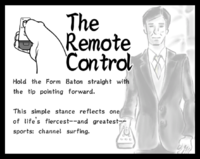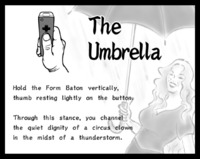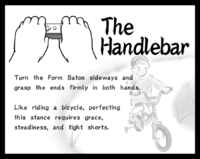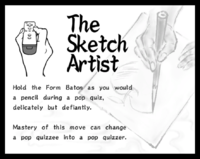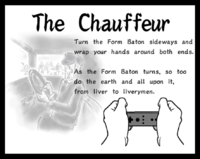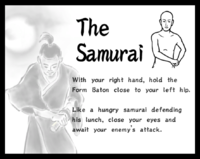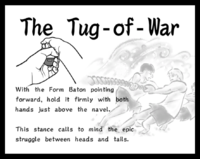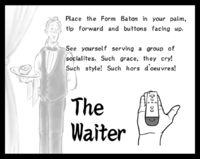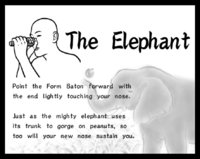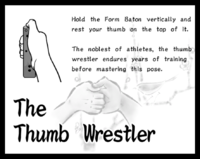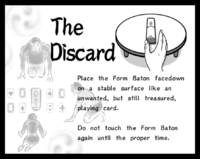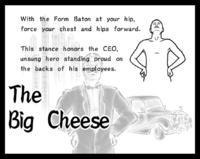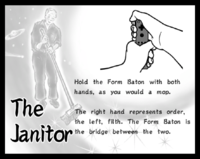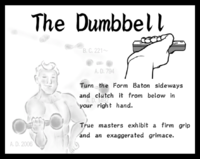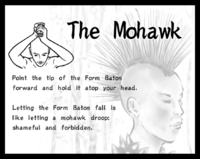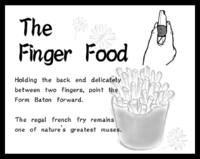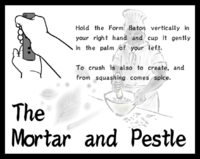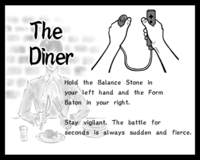Form Baton
- "Forms" redirects here. For information about different forms that several Mario characters can take, see Category:Forms.
The Form Baton is the most important object in WarioWare: Smooth Moves. Wario stumbled in on this mysterious device in a place called the Temple of Form. He soon finds out that how one uses it depends on the way one holds it. Then, he goes off and shares it with his friends at WarioWare. It turns out that the Form shown is how the player must use the Wii Remote to play the game (in-game instructions actually refer to the Wii Remote as the "Form Baton"). The Form Baton also has a Nunchuk counterpart, the Balance Stone, shown in the final stage of the game.
Forms
Forms, as the name implies, are the modes of holding the ![]() Form Baton (Wii Remote) in WarioWare: Smooth Moves. The forms are introduced by the Form Explanation, which acts as an often comedic tutorial of how to use each form. Each form is used for certain microgames in the game. Below is a list of forms (and compatible microgames) in order of their appearance:
Form Baton (Wii Remote) in WarioWare: Smooth Moves. The forms are introduced by the Form Explanation, which acts as an often comedic tutorial of how to use each form. Each form is used for certain microgames in the game. Below is a list of forms (and compatible microgames) in order of their appearance:
The Remote Control
Appears in
^None of Tiny Wario's games use the Remote Control. Instead, some of Wario's microgames appear in Tiny Wario's stage.
In-game text
- Description: "This is the most basic and popular of all the forms."
- Form Explanation (localized version):
Hold the Form Baton straight with the tip pointing forward.
This simple stance reflects one of life's fiercest--and greatest--sports: channel surfing.
- Form Explanation (Japanese version):
- Japanese script:
作法棒の先端を正面に向け、離母魂を持つように真っ直ぐ構えましょう。
素朴さゆえに隙がないその姿は、すべての作法の基本です。
- Romanization:
Sahō Bō no sentan o shōmen ni muke, rimokon o motsu yō ni massugu kamaemashō.
Soboku sa yue ni suki ga nai sono sugata wa, subete no sahō no kihon desu.
- Translation:
With the tip of the Form Baton pointing forward, hold it ready just like a remote control.
Due to its simplicity, this effortless form is the basis for all modes.
Microgames
Names in other languages
| Language | Name | Meaning |
|---|---|---|
| Japanese | 正面 Shōmen |
Front |
| German | Die Fernbedienung |
The Remote Control |
| Italian | Il telecomando |
The remote control |
| Korean | 리모컨 Rimokeon |
Contraction of "Remote Control" in Korea |
| Spanish | El zapeador |
The zapper |
The Umbrella
Appears in
In-game text
- Description: "After the Remote Control, this is the second-most-popular form."
- Form Explanation (localized version):
Hold the Form Baton vertically, thumb resting lightly on the button.
Through this stance, you channel the quiet dignity of a circus clown in the midst of a thunderstorm.
- Form Explanation (Japanese version):
- Japanese script:
作法棒を縦に構え、親指をそっと牡丹に乗せましょう。
その姿は、荒々しい滝を登る鯉のように美しく、見る者の心を奪います。
- Romanization:
Sahō Bō o tate ni kamae, oyayubi o sotto botan ni nosemashō.
Sono sugata wa, araarashii taki o noboru koi no yō ni utsukushiku, miru mono no kokoro o ubaimasu.
- Translation:
With the Form Baton in vertical position, place your thumb gently on the button.
This form, beautiful as the koi that climbs violent waterfalls, steals the hearts of those who see it.
Microgames
Names in other languages
| Language | Name | Meaning |
|---|---|---|
| Japanese | 滝登り Taki Nobori |
Waterfall climbing |
| German | Der Regenschirm |
The Umbrella |
| Italian | L'ombrello |
The umbrella |
| Korean | 우산 Usan |
Umbrella |
| Spanish | El paraguas |
The umbrella |
The Handlebar
Appears in
In-game text
- Description: "This is the most balanced form. Most Handlebar games require quick movements."
- Form Explanation (localized version):
Turn the Form Baton sideways and grasp the ends firmly in both hands.
Like riding a bicycle, perfecting this stance requires grace, steadiness, and tight shorts.
- Form Explanation (Japanese version):
- Japanese script:
作法棒を横に倒し、両端を上からしっかり握りましょう。
ただし、逆さまに持ってはいけません。禁じ手です。
- Romanization:
Sahō Bō o yoko ni taoshi, ryōhashi o ue kara shikkari nigirimashō.
Tadashi, sakasama ni motte wa ikemasen. Kinjite desu.
- Translation:
Turn the Form Baton horizontally and grasp both ends firmly from above.
You must not, however, hold it upside down: that is a forbidden move.
Microgames
Names in other languages
| Language | Name | Meaning |
|---|---|---|
| Japanese | 両握り Ryō nigiri |
Grasping with both hands |
| German | Die Stange |
The Rod |
| Italian | Il manubrio |
The handlebar |
| Korean | 자전거 Jajeongeo |
Bicycle |
| Spanish | El manillar |
The handlebar |
The Sketch Artist
Appears in
|
In-game text
- Description: "This form is best suited for movements requiring precision. Use your dominant hand to perform this form."
- Form Explanation (localized version):
Hold the Form Baton as you would a pencil during a pop quiz, delicately but defiantly.
Mastery of this move can change a pop quizee into a pop quizzer.
- Form Explanation (Japanese version):
- Japanese script:
作法棒の先端を正面に向け、鉛筆のように持ちましょう。
指先から作法棒に魂を送り込めるようになると、達人と呼ばれます。
- Romanization:
Sahō Bō no sentan o shōmen ni muke, enpitsu no yō ni mochimashō.
Yubisaki kara Sahō Bō ni tamashii o okurikomeru yō ni naru to, tatsujin to yobaremasu.
- Translation:
With the tip of the Form Baton pointing forward, hold it like a pencil.
When you are able to send your spirit from your fingertips to the Form Baton, then you will be called master.
Microgames
Names in other languages
| Language | Name | Meaning |
|---|---|---|
| Japanese | 達筆 Tappitsu |
Writing expertise |
| German | Der Zeichner |
The Artist |
| Italian | Il disegnatore |
The draftsman |
| Korean | 화가 Hwaga |
Artist |
| Spanish | El dibujante |
The cartoonist |
The Chauffeur
Appears in
In-game text
- Description: "This form is best suited for gyrating movements."
- Form Explanation (localized):
Turn the Form Baton sideways and wrap your hands around both ends.
As the Form Baton turns, so too do the earth and all upon it, from liver to liverymen.
- Form Explanation (Japanese version):
- Japanese script:
作法棒を横に倒し、両手で包み込むように持ちましょう。
『まーわりゃんせーまわりゃんせーおなじぼうならまわさにゃそんそん』
- Romanization:
Sahō Bō o yoko ni taoshi, ryōte de tsutsumikomu yō ni mochimashō.
"Māwaryansē mawaryansē onaji bō nara mawasanya son son"
- Translation:
Turn the Form Baton horizontally and hold it with both hands like you are wrapping it.
"Turn it, please, turn it. As they are bars alike, why not to turn it?"
Microgames
Names in other languages
| Language | Name | Meaning |
|---|---|---|
| Japanese | まわりゃんせ Mawaryanse |
Please turn |
| German | Das Lenkrad |
The Steering Wheel |
| Italian | L'autista |
The driver |
| Korean | 운전기사 Unjeongisa |
The Chauffeur |
| Spanish | El chófer |
The chauffeur |
Trivia
- The Japanese form explanation includes a verse based on Awa Yoshikono, a song associated with the Awa Odori Festival in Japan.
The Samurai
Appears in
- Description: "You can feel the spirit of the samurai in this form. It's said that your breathing affects the outcome."
- Form Explanation (localized version):
With your right/left hand, hold the Form Baton close to your left/right hip.
Like a hungry samurai defending his lunch, close your eyes and await your enemy's attack.
- Form Explanation (Japanese version):
- Japanese script:
作法棒を(右手/左手)で握り、(左/右)の腰のあたりに当てて構えましょう。
目を閉じゆっくり息を整え、襲いくる敵を持つのです。
- Romanization:
Sahō Bō o migite/hidarite de nigiri, hidari/migi no koshi no atari ni atete kamaemashō.
Me o tojiyukkuri iki o totonoe, osoikuru teki o motsu no desu.
- Translation:
Grasp the Form Baton with your right/left hand and hold it against your left/right hip.
Close your eyes and breathe slowly to survive the opponent’s attack.
Microgames
Names in other languages
| Language | Name | Meaning |
|---|---|---|
| Japanese | 下段の構え Gedan no kamae |
Low-level position |
| German | Der Samurai |
The Samurai |
| Italian | Il samurai |
The samurai |
| Korean | 무사 Musa |
Warrior |
| Spanish | El samurai |
The samurai |
The Tug-of-War
- Description: "This form has been taught from generation to generation. Lately, the tend has been to bring the hands closer together."
- Form Explanation (localized version):
With the Form Baton pointing forward, hold it firmly with both hands just above the navel.
This stance calls to mind the epic struggle between heads and tails.
- Form Explanation (Japanese version):
- Japanese script:
作法棒の先端を正面に向け、両手でしっかり握りましょう。
臍の上あたりで構えるのが通です。
- Romanization:
Sahō Bō no sentan o shōmen ni muke, ryōte de shikkari nigirimashō.
Heso no ue atari de kamaeru no ga tsū desu.
- Translation:
With the Form Baton pointing forward, hold it firmly with both hands.
Experts hold it just above the navel.
Microgames
Names in other languages
| Language | Name | Meaning |
|---|---|---|
| Japanese | 綱引き Tsunahiki |
Tug-of-War |
| German | Das Tauziehen |
The Tug-of-War |
| Italian | Tiro alla fune |
Tug-of-war |
| Korean | 줄다리기 Juldarigi |
Tug-of-War |
| Spanish | El tira y afloja |
The tug-of-war |
The Waiter
- Description: "It's very easy to drop the Form Baton when performing this form, so be careful."
- Form Explanation (localized version):
Place the Form Baton in your palm, tip forward and buttons facing up.
See yourself serving a group of socialites. Such grace, they cry! Such style! Such hors d'oeuvres!
- Form Explanation (Japanese version):
- Japanese script:
作法棒の先端の正面に向け、牡丹を上にした状態で掌に乗せましょう。
掌は大海原を、作法棒は小舟をあらわし、その雄大な姿は見る者を圧倒します。
- Romanization:
Sahō Bō no sentan o shōmen ni muke, botan o ue ni shita jōtai de tenohira ni nosemashō.
Tenohira wa ōunabara o, Sahō Bō wa kobune o arawashi, sono yūdai na sugata wa miru mono o attōshimasu.
- Translation:
With the Form Baton pointing forward, place it on the palm of your hand leaving the buttons facing up.
As your palm represents the vast ocean, and the Form Baton represents a boat, this magnificent form overwhelms those who see it.
Microgames
Names in other languages
| Language | Name | Meaning |
|---|---|---|
| Japanese | 手乗り Te-nori |
To Ride on the Hand |
| German | Der Kellner |
The Waiter |
| Italian | Il cameriere |
The waiter |
| Korean | 웨이터 Weiteo |
Waiter |
| Spanish | El camarero |
The waiter |
The Elephant
In-game text
- Description: "This form will make your nose look longer, but the point is to make it look appealing."
- Form Explanation (localized version):
Hold the Form Baton forward with the end lightly touching your nose.
Just as the mighty elephant uses its trunk to gorge on peanuts, so too will your new nose sustain you.
- Form Explanation (Japanese version):
- Japanese script:
作法棒の先端を正面に向け、鼻の前に掲げましょう。
長く伸びた鼻先からは不思議な力が発せられているとかいないとか。
- Romanization:
Sahō Bō no sentan o shōmen ni muke, hana no mae ni kakagemashō.
Nakaku nobita hanasaki kara wa fushigi na chikara ga hasserarete iru to ka inai to ka.
- Translation:
With the tip of the Form Baton pointing forward, hold it in front of your nose.
From the tip of the elongated nose, miraculous power may be emitted or not.
Microgames
Names in other languages
| Language | Name | Meaning |
|---|---|---|
| Japanese | 天狗 Tengu |
Tengu |
| German | Der Elefant |
The Elephant |
| Italian | L'elefante |
The elephant |
| Korean | 코끼리 Kokkiri |
Elephant |
| Spanish | La trompa |
The trunk |
Trivia
- The Spanish version of the form explanation states that this form is used as a "punishment for liars", a reference to Pinocchio.
The Thumb Wrestler
In-game text
- Description: "This relatively new form is actually an evolved version of the Umbrella. Is it just me, or does the evolution seem like a minor one?"
- Form Explanation (localized version):
Hold the Form Baton vertically and rest your thumb on the top of it.
The noblest of athletes, the thumb wrestler endures years of training before mastering this pose.
- Form Explanation (Japanese version):
- Japanese script:
作法棒を縦に構え、親指で棒の上部をおさえましょう。
親指を離したときに放たれる力は馬三頭分に匹敵します。
- Romanization:
Sahō Bō o tate ni kamae, oyayubi de bō no jōbu o osaemashō.
Oyayubi o hanashita toki ni hanatareru chikara wa uma santōbun ni hittekishimasu.
- Translation:
With the Form Baton in vertical position, press your thumb on the top of the baton.
When you let go of your thumb, the power released equals that of three horses.
Microgames
Names in other languages
| Language | Name | Meaning |
|---|---|---|
| Japanese | 指相撲 Yubizumō |
Thumb-Wrestling |
| German | Der Daumencatcher |
The Thumb Catcher |
| Italian | Battaglia di pollici |
The thumb wrestling |
| Korean | 엄지 씨름 Eomji Ssireum |
Thumb wrestling |
| Spanish | El luchador de pulgar |
The thumb wrestler |
The Discard
In-game text
- Description: "It's helpful to have a flat surface nearby when playing these games."
- Form Explanation (localized version):
Place the Form Baton facedown on a stable surface like an unwanted, but still treasured, playing card.
Do not touch the Form Baton again until the proper time.
- Form Explanation (Japanese version):
- Japanese script:
安定した台の上に作法棒を裏返して置きましょう。
踊りが始まるまでは何人たりとも作法棒に触れてはいけません。
- Romanization:
Anteishita dai no ue ni Sahō Bō o urakaeshite okimashō.
Odori ga hajimaru made wa nanpito taritomo Sahō Bō ni sawarete wa ikemasen.
- Translation:
Turn the Form Baton upside down and place it on a stable surface.
No one should touch the Form Baton before it starts dancing.
Microgames
|
Names in other languages
| Language | Name | Meaning |
|---|---|---|
| Japanese | 置き Oki |
Place |
| German | Die Ablage |
The Filing |
| Italian | Il recupero |
The recovery |
| Korean | 카드놀이 Kadeunol'i |
Card playing |
| Spanish | La paciencia |
The patience |
The Big Cheese
In-game text
- Description: "Show-offs are quick to learn this form. However, that does not mean they do it well."
- Form Explanation (localized version):
With the Form Baton at your hip, force your chest and hips forward.
This stance honors the CEO, unsung hero standing proud on the backs of his employees.
- Form Explanation (Japanese version):
- Japanese script:
作法棒を腰に当て、後方に反り返りましょう。
自信に満ちた表情をするとよりと効果的です。
- Romanization:
Sahō Bō o koshi ni ate, kōhō ni sorikaerimashō.
Jishin ni michita hyōjō o suru to yori to kōkateki desu.
- Translation:
Hold the Form Baton against your hips and throw out your chest.
It is more effective if you have a confident expression on your face.
Microgames
Names in other languages
| Language | Name | Meaning |
|---|---|---|
| Japanese | 大威張り Ō ibari |
Big Boaster |
| German | Der Hula-Hula |
The Hula-Hula |
| Italian | Il grande capo |
The big boss |
| Korean | 회장님 Hoejangnim |
The Chairman |
| Spanish | El gerifalte |
The gerfalcon |
The Janitor
In-game text
- Description: "This form is as hardworkng and effective as its name implies. Little-known fact: the Janitor is just the Tug-of-War turned upright."
- Form explanation (localized version):
Hold the Form Baton with both hands, as you would a mop.
The left/right hand represents order, the right/left, filth. The Form Baton is the bridge between the two.
- Form Explanation (Japanese version):
- Japanese script:
作法棒を縦にし、両手でしっかり握りましょう。
(右手/左手)は天を、(左手/右手)は大地をあらわし、作法棒は天地を繋ぐ架け橋です。
- Romanization:
Sahō Bō o tate ni shi, ryōte de shikkari nigirimashō.
Migite/Hidarite wa ten o, hidarite/migite wa daichi o arawashi, Sahō Bō wa tenchi o tsunagu kakehashi desu.
- Translation:
Hold the Form Baton vertically and hold it with both hands.
The right/left hand represents heaven, and the left/right hand represents earth. The Form Baton is the bridge that connects them.
Microgames
|
Names in other languages
| Language | Name | Meaning |
|---|---|---|
| Japanese | 聖徳太子 Shōtokutaishi |
Prince Shōtoku |
| German | Der Straßenkehrer |
The Sweeper |
| Italian | Il bidello |
The janitor |
| Korean | 관리인 Gwanri'in |
The janitor |
| Spanish | El barrendero |
The sweeper |
The Dumbbell
In-game text
- Description: "This is an easy way to hold the Form Baton, and it provides a satisfying weight in your palm."
- Form Explanation (localized version):
Turn the Form Baton sideways and clutch it from below in your right/left hand.
True Masters exhibit a firm grip and an exaggerated grimace.
- Form Explanation (Japanese version):
- Japanese script:
作法棒を横に倒し、下から逆手で握りましょう。
軽いはずの作法棒から歴史の重みが伝わってきませんか?
- Romanization:
Sahō Bō o yoko ni taoshi, shita kara sakate de nigirimashō.
Karui hazu no Sahō Bō kara rekishi no omomi ga tsutawatte kimasen ka?
- Translation:
Turn the Form Baton horizontally and grip it from below.
Does not the seemingly light Form Baton convey the weight of history?
Microgames
Names in other languages
| Language | Name | Meaning |
|---|---|---|
| Japanese | 鉄亜鈴 Tetsu arei |
Iron Dumbbell |
| German | Die Hantel |
The Dumbbell |
| Italian | I pesi |
The weights |
| Korean | 아령 Aryeong |
Dumbbell |
| Spanish | La mancuerna |
The dumbbell |
The Mohawk
In-game text
- Description: "Games that use this form require whole-body movement. It might be a bit of a challenge for players who have not exercised in a while."
- Form Explanation (localized version):
Point the tip of the Form Baton forward and hold it atop your head.
Letting the Form Baton fall is like letting a mohawk droop: shameful and forbidden.
- Form Explanation (Japanese version):
- Japanese script:
作法棒の先端を正面に向け、頭の上に乗せましょう。
この作法中に頭から作法棒をおとすことは大変無礼な行為とされています。
- Romanization:
Sahō Bō no sentan o shōmen ni muke, atama no ue ni nosemashō.
Kono sahōchū ni atama kara Sahō Bō o odosu koto wa taihenburei na kōi to sarete imasu.
- Translation:
With the tip of the Form Baton pointing forward, place it on top of your head.
While in this pose, dropping the Form Baton from your head is considered very rude.
Microgames
Names in other languages
| Language | Name | Meaning |
|---|---|---|
| Japanese | ちょんまげ Chonmage |
Topknot |
| German | Der Irokese |
The Iroquois |
| Italian | Il moicano |
The Mohawk |
| Korean | 모히칸 Mohikan |
Mohican |
| Spanish | El iroqués |
The iroquois |
The Finger Food
In-game text
- Description: "This form requires fingertip strength and control. It's best suited for relatively uncomplicated games."
- Form Explanation (localized version):
Holding the back end delicately between two fingers, point the Form Baton forward.
The regal french fry remains one of nature's greatest muses.
- Form Explanation (Japanese version):
- Japanese script:
作法棒の先端を正面に向け、背面からそっとつまみましょう。
やさしくかつしっかりと。繊細な力加減が美しさを際だたせます。
- Romanization:
Sahō Bō no sentan o shōmen ni muke, haimen kara sotto tsumamimashō.
Yasashiku katsu shikkari to. Sensai na chikara kagen ga utsukushisa o kiwadatasemasu.
- Translation:
With the tip of the Form Baton pointing forward, pinch it slightly from the rear tip.
Gently yet firmly. The delicate amount of strength makes beauty prominent.
Microgames
Names in other languages
| Language | Name | Meaning |
|---|---|---|
| Japanese | おつまみ O tsumami |
Snack |
| German | Die Frittenfinger |
The Finger Fries |
| Italian | Con le dita |
With the fingers |
| Korean | 감자튀김 Gamjatwigim |
French fries |
| Spanish | La sibarita |
The epicure |
The Boxer
In-game text
- Description: "Compared to the other forms, this is the most relaxed way of holding the Form Baton."
- Form Explanation (localized version):
Turn the Form Baton and hold it firmly from above in your right/left hand.
Let the spirit of the noble sucker punch guide you to victory.
- Form Explanation (Japanese version):
- Japanese script:
作法棒を横に倒し、(右手/左手)で上からしっかり握りましょう。
みなぎる力をすべて作法棒に注ぎ込む心意気が、新しい時代を切り開きます。
- Romanization:
Sahō Bō o yoko ni taoshi, migite/hidarite de ue kara shikkari nigirimashō.
Minagiru chikara o subete Sahō Bō ni sosokikomu kokoro iki ga, atarashii jidai o kirihirakimasu.
- Translation:
Turn the Form Baton horizontally and hold it from above with your right/left hand.
The spirit to pour all the overflowing power into the Form Baton makes way to a new era.
Microgames
Names in other languages
| Language | Name | Meaning |
|---|---|---|
| Japanese | 岡っ引き Okappiki |
Hawkshaw |
| German | Der Boxer |
The Boxer |
| Italian | Il pugile |
The boxer |
| Korean | 권투 Gweontu |
Boxing |
| Spanish | El boxeador |
The boxer |
The Mortar and Pestle
In-game text
- Description: "This form is interesting because it places much responsibility on the non-dominant hand, the left/right hand."
- Form explanation (localized version):
Hold the Form Baton vertically in your right/left hand and cup it gently in the palm of your left/right
To crush is also to create, and from squashing comes spice.
- Form Explanation (Japanese version):
- Japanese script:
作法棒を(右手/左手)で縦に構え、(左/右)の掌そっと乗せましょう。
自在に動く作法棒の姿からいつしか『小坊主』の呼び名がつきました。
- Romanization:
Sahō Bō o migite/hidarite de tate ni kamae, hidari/migi no tenohira sotto nosemashō.
Jizai ni ugoku Sahō Bō no sugata kara itsushika "kobōzu" no yobi na ga tsukimashita.
- Translation:
Holding the Form Baton vertically with your right/left hand, place it on your left/right palm.
Before you notice, the freely-moving form will have had you be called “kobōzu.”
Microgames
Names in other languages
| Language | Name | Meaning |
|---|---|---|
| Japanese | 小坊主 Kobōzu |
Little Monk |
| German | Der Stößel |
The Pestle |
| Italian | Mortaio e pestello |
Mortar and pestle |
| Korean | 막자사발 Makjasabal |
Pestle |
| Spanish | El mortero |
The mortar |
The Diner
In-game text
- Description:
"You need the Balance Stone for this form. There are actually three versions of the Diner."
- Form Explanation (localized version):
Hold the Balance Stone in your left/right hand and the Form Baton in your right/left.
Stay vigilant. The battle for seconds is always sudden and fierce.
- Form Explanation (Japanese version):
- Japanese script:
作法棒とにぎり石を繋ぎ、作法棒を(右手/左手)で、にぎり石を(左手/右手)で、しっかり握りましょう。
引っ張りすぎると危険です。冷静かつ大胆な踊りを心がけてください。
- Romanization:
Sahō Bō to Nigiri Ishi o tsunagi, Sahō Bō o migite/hidarite de, Nigiri Ishi o hidarite/migite de, shikkari nigirimashō.
Hipparisugiru to kiken desu. Reisei katsu daitan na odori o kokorogakete kudasai.
- Translation:
Connect the Form Baton to the Balance Stone and firmly hold the Form Baton on your right/left hand and the Balance Stone in your left/right hand.
It is dangerous to pull too much: please try to dance calmly yet boldly.
Modes
- A: Point the
 and the
and the  up.
up. - B: Point the
 and the
and the  forward.
forward. - C: Point the
 and the
and the  to each other.
to each other.
Microgames
|
|
|
|
|
|
Names in other languages
| Language | Name | Meaning |
|---|---|---|
| Japanese | 二刀流 Nitōryū |
Dual Blade Style |
| German | Das Besteck |
The Cutlery |
| Italian | A tavola |
More or less "It's ready" |
| Korean | 레스토랑 Reseutorang |
Restaurant |
| Spanish | El comensal |
The diner |
Names in other languages
| Language | Name | Meaning |
|---|---|---|
| Japanese | 作法棒 Sahō bō |
Etiquette Bar |
| German | Formenstab |
Form Bar |
| Italian | Bacchetta multiforme |
Multiform baton |
| Spanish | Watuta |
Possibly a pun in Batuta (Baton) and Wii (or Wario). |
Trivia
- The way that Wario takes the Form Baton is similar to one of the events from the movie Indiana Jones and the Raiders of the Lost Ark, in which Indiana Jones takes the golden idol out of the Lost Temple and gets chased by a boulder, one of the temple's obstacles.

